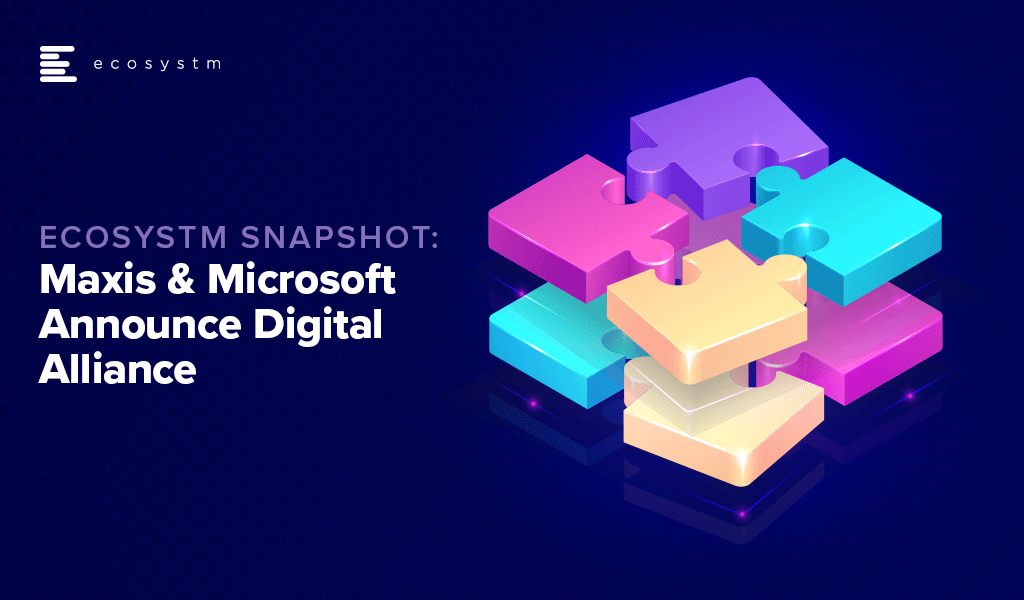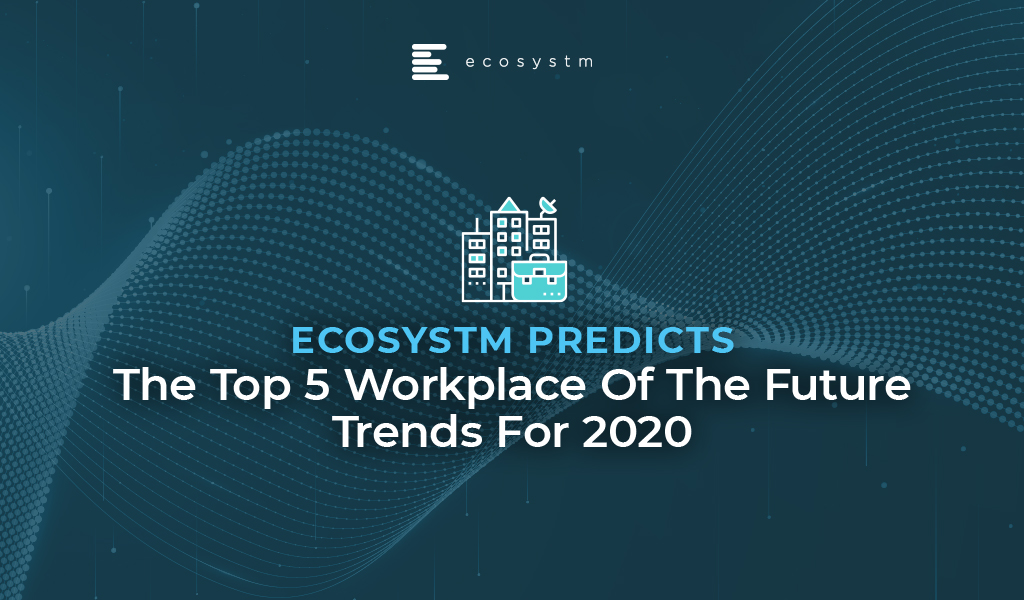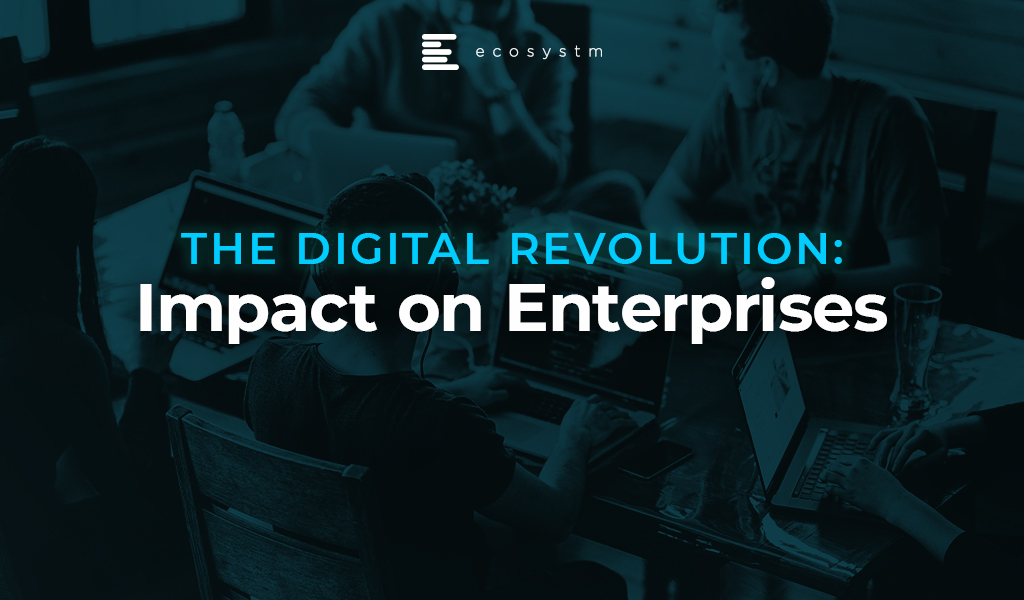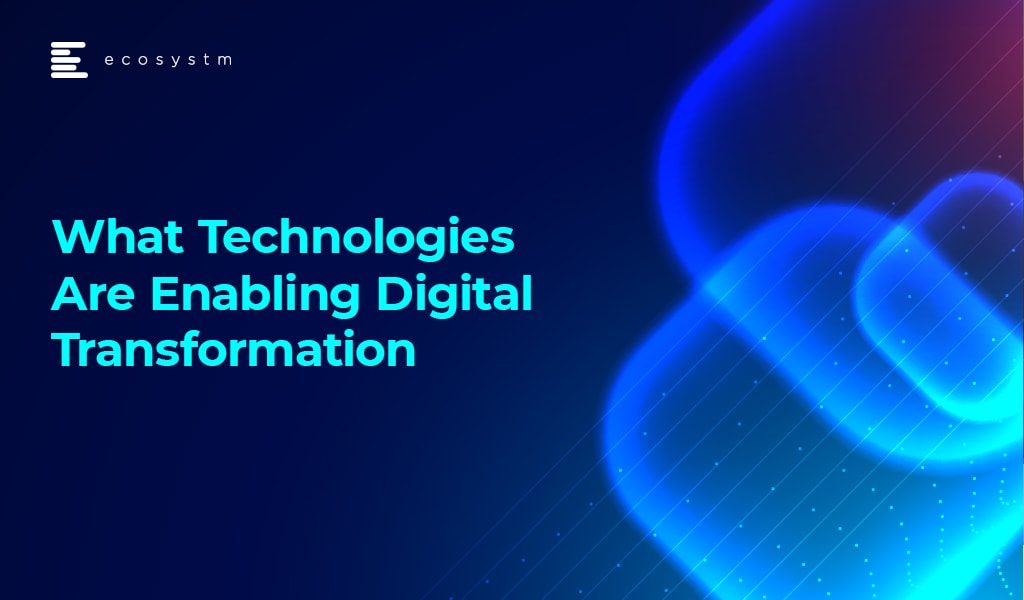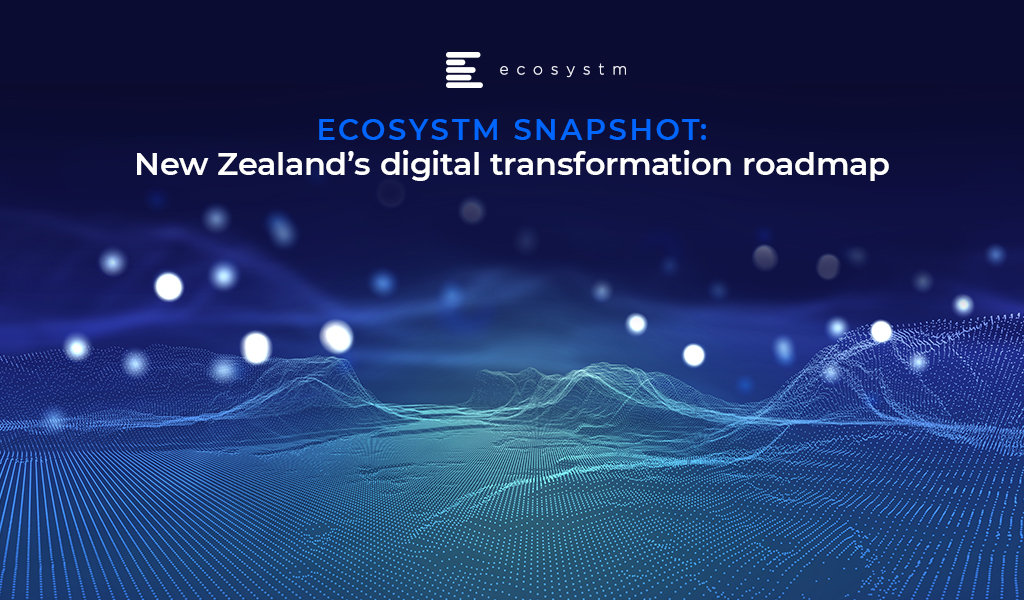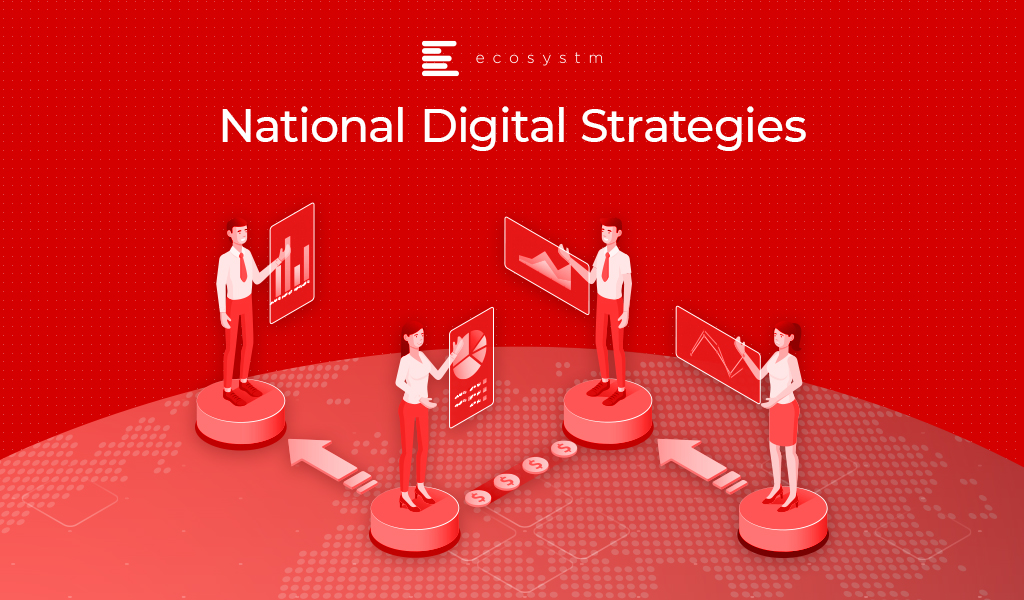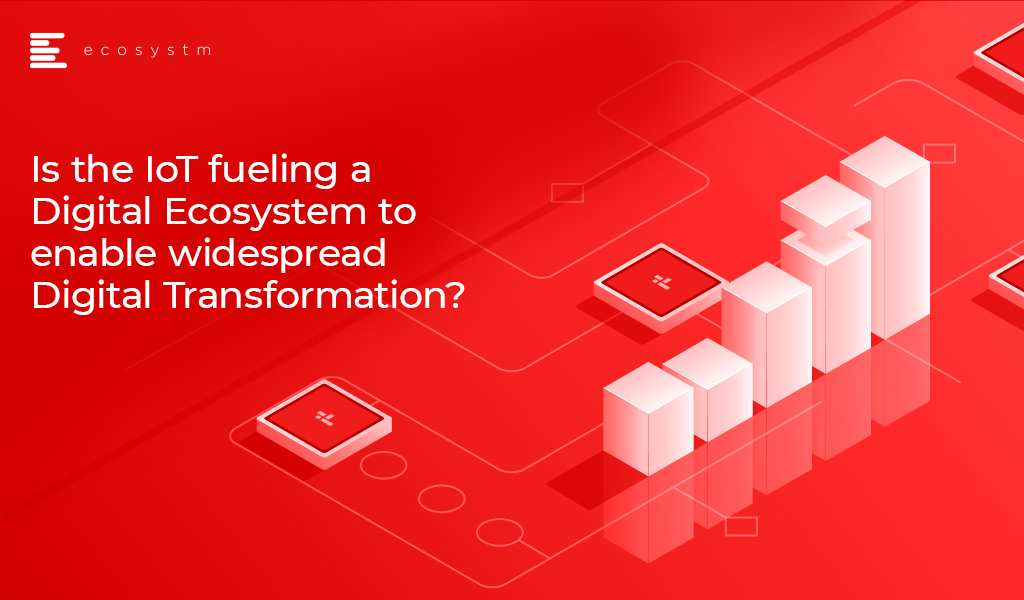At the end of last year, Ecosystm published The Top 5 IoT Trends for 2020. Principal advisors, Kaushik Ghatak and Francisco Maroto predicted that in 2020 5G providers will be forced to operate outside their comfort zone. While the impact on network and communications equipment providers will be immense, 5G will also force telecom providers to re-think their existing business models. They may not be the best equipped to take 5G technology to market, they way the operate now.
Traditionally telecom providers have been focused on horizontal technologies and on connecting people. They have not had to have conversations around connecting machines – where every industry has their own unique use cases. This verticalisation, will force telecom providers to deal with newer stakeholders in their client organisations – not just IT infrastructure and Facilities. Several telecom providers have in the past become public cloud providers, as their markets becomes smaller and they face competition from global cloud storage providers. Now, telecom providers will increasingly look to partner with cloud providers and systems integrators with relevant industry experience, to translate the value proposition of what they are offering. “Strategic partnerships between leading technology and telecom operators are taking place especially in building various 5G use cases and applications centred on the cloud computing platform,” says Shamir Amanullah, Principal Advisor Ecosystm.
Maxis Strengthening their Market Position in Malaysia
The recently announced partnership between Maxis and Microsoft is an example of how these partnerships will pan out. Maxis does not want to be viewed only as a telecom provider and wants to be the leading Malaysia-based solutions provider. As telecom providers also start to tap the enterprise market, cloud and IoT will be key technology areas, that they should focus on.
“Maxis is leading the way as a converged solutions provider in Malaysia and following the appointment of Gökhan Ogut as the CEO in 2019, there has been a focus to grow the enterprise business which promises a lucrative opportunity,” says Amanullah.
“While the mobile connectivity market is effectively about customer retention in a saturated market, new opportunities lie in enterprise needs for fixed connectivity, managed services, cloud and IoT which is largely untapped. The expected deployment of the 5G network will spur new applications, business models and partnerships.”
Maxis’ move appears to be well-thought. Amanullah thinks that the strategic partnership with Microsoft will help Maxis accelerate its enterprise solutions offering combined IoT and 5G capabilities with Microsoft’s Azure IoT technology. It will also allow for hybrid environments, which is important given the rise of hybrid and multi-cloud adoption. Ecosystm research shows that hybrid cloud adoption in Malaysia is at a nascent 7%. But if they take a lesson from their neighbour, the rise in adoption will be steep. Our research finds that hybrid cloud adoption in Singapore is around 42%.
Telecom providers are also focusing on Digital Transformation (DX). In the Top 5 Telecommunications & Mobility Trends for 2020, Liam Gunson, Director Ecosystm says, “In 2020, operators will focus on transforming the core – remove unnecessary costs, improve customer experience, capture new opportunities – and on building telecom networks with scalability, flexibility, efficiency and agility.” Microsoft’s enterprise Modern Workplace solutions including Microsoft Teams will aid Maxis’ own DX efforts. Maxis will offer fixed line voice calls with the unified communications service.
Mutually Beneficial Partnership
Amanullah also sees this as a positive move for Microsoft. “Microsoft is poised to lead efforts in 5G network deployment which promises to enhance capabilities and drive new economic growth, especially with the focus on Industry 4.0. Maxis’ position as a leading enterprise communications provider and Microsoft’s enterprise technology experience and offerings promises a mutually beneficial partnership.”
Ecosystm research finds that Microsoft is the leading cloud provider in Malaysia when it comes to brand perception, and about a third of enterprise cloud deployments use Microsoft. Amanullah thinks that, “Microsoft’s leading position in cloud platforms is an attractive proposition for enterprises that are looking at speed, performance, reliability, global scale, security and lower costs.”
Talking about the 5G applications that the Malaysia market will see, Amanullah sees tremendous business opportunities in areas such as smart city, autonomous driving, smart traffic management, virtual reality (VR), augmented reality (AR), cloud gaming, and healthcare, to name a few.
As the ‘Experience Economy’ becomes a reality, organisations will look beyond improving customer experience (CX) to enhancing employee experience (EX). It is estimated that people spend a third of their life at their workplaces. This realisation will drive organisations to focus on EX over priorities such as growing revenue or reducing costs. Retaining employees is important in today’s war for talent – and organisations have started appointing Chief Experience Officers. Ultimately, workplace technology should drive employee productivity – and there is a proven link between happy and productive employees.
The Top 5 Workplace Of The Future Trends For 2020
The Top 5 Workplace of the Future trends are drawn from the findings of the global Ecosystm CX Study and are also based on qualitative research by Ecosystm Principal Advisors, Tim Sheedy and Audrey William.
-
Employee Experience as a Business Focus Will Drive Faster Adoption of Consumer Collaboration Tools
Organisations in mature economies already have employee experience (EX) and CX as their top business priorities. This comes with an understanding that offering a great customer and employee experience will lead to revenue growth, profit growth and lower costs.
For communication and collaboration solutions, if the experience is not right, employees will move on to the next best app for the right experience. The competition between the vendors across voice, video and collaboration is heightening. It may sound simple but that is where the innovation needs to happen in the industry. If employees do not like what IT has provided for them, they will download the application of their choice for work. This will be a huge challenge especially in industries that are heavily regulated such as Financial Services and Healthcare.
-
HR KPIs Will Drive IT Teams to Invest in Workplace Analytics
HR teams are ultimately responsible for driving improved EX. And a happy employee is a productive employee – so an employee’s environment (managed by the Operations or Facilities team) and their technology (managed by the IT team) will have the biggest impact on driving employee satisfaction. To drive these outcomes, we will see these three teams work closer than they ever have – and not just on a project basis, but as a permanent arrangement.
Investments in Workplace Analytics will increase, and there will be more collaboration between IT, HR and Facilities Management to drive best practices for employees. Right now, there is very little collaboration between the three departments in driving better workplace practices. Workplace Analytics will help solve problems related to poor office practices around email overload, long work hours, absenteeism, usage of rooms and other facilities, employee discontent, as well as understand the overall trends on communications and collaboration solutions usage.
-
5G Services will Push Organisations to Rethink their Network
Today 5G is not available in many countries – and where it is available coverage is generally spotty. But this will change in 2020 as more operators launch or expand their 5G coverage. The unique capabilities of 5G to offer software-defined networks (SDNs) – designed specifically for organisations’ needs – will help businesses rethink the way they operate. They can stop thinking of their network as a physical place and start thinking of it as a set of capabilities and this takes work beyond designated physical addresses. Retailers will be able to offer complete retail environments from wherever they choose. Banks will be able to offer complete in-branch services from anywhere. Employees will be able to get access to all sorts of data and systems regardless of location. 5G is about much more than a faster network – the potential to transform enterprise networks will see a huge rethink of the network and the way IT teams provide technology services to their employees.
-
Organisations Will Wake Up to the Need for the Right Knowledge Management Solution
IT has been guilty of dictating the knowledge management (KM) requirements and platforms to the business. Many customer teams are using tools that are inherently wrong for the job. Management is using tools that do not support their needs, and information workers are given generic platforms when they have specific needs. 2020 will see a fragmentation of the KM market as businesses start to buy based on customer and employee needs – not based on what the IT team dictates.
-
2020 Will See a Rise in CPaaS Adoption
Cloud-based platforms that enable developers to add real-time communications features within the workflow of their own business applications will be the next big area of innovation in the unified communications space. Through the use of APIs, developers can embed communication capabilities into their existing business applications, without extra hardware or software costs. Developers can embed it directly into the cloud platform so the time to market is fast. Communications Platform as a Service (CPaaS) will see greater adoption as more organisations look to build code and apply agile and DevOps methodologies.
Download Report: The top 5 Workplace of the future trends for 2020
The full findings and implications of the report ‘Ecosystm Predicts: The Top 5 Workplace of the future Trends for 2020’ are available for download from the Ecosystm platform. Signup for Free to download the report and gain insight into ‘the top 5 Workplace of the future trends for 2020’, implications for tech buyers, implications for tech vendors, insights, and more resources. Download Link Below ?

As a technology analyst I have followed HCL for many years – and their capabilities have changed over that time – particularly in Australia and New Zealand. When they entered the ANZ market they were somewhat unique – an Indian IT Service provider with views and opinions. One who was not just good at meeting RFP requirements and delivering technology projects, but also individuals who were empowered to challenge the status quo in their clients – to challenge clients to be better. But as several large managed services providers lost their way in ANZ, HCL stepped in and – for a number of years – became all about outsourcing and managed services. They grew their business significantly, but what seemed to be lost was that factor that set them apart. In focusing on good delivery they seemed to lose their differentiator.
However, I recently spent a few days with HCL and their clients in Adelaide and I can report that they are back. They are winning digital transformation deals. They are driving a technology industry agenda and are becoming an important force in the education and evolution of the high tech sector in Australia and New Zealand. Adelaide was chosen for the event as HCL wanted to showcase how they are making real investments in the local market, and how they are helping South Australia to transform itself and create new job opportunities both in Adelaide and in the regions. Their managed services contract with Elders is a great starting point for them – and in meeting and interviewing the Elders stakeholders, it is clear that it is a partnership – HCL has collocated to ensure that the HCL staff are side-by-side with the Elders teams – and they are doing a good job in driving innovation into the Elders business.
The Cricket Australia digital transformation contract is a big deal, and is really a great indicator of their capabilities. HCL won the contract from Accenture – showing that they can compete against and beat the best (Accenture is the biggest IT services provider in Australia today – and for good reason). Building off their success with Manchester United, HCL has won another important digital transformation deal with a global sporting brand. Personally, as a fan of the Australian women’s and men’s cricket team, I look forward to engaging with the fruits of their endeavours soon!
The main take away from the time spent with HCL is that they are growing their business here in Australia and across the entire Asia Pacific region – and that the growth is coming from many areas – not just traditional outsourcing contracts but also across the spectrum of digital transformation. Importantly they are also taking responsibility for that growth – bringing the market along with them as they look to help educate and employ the next generation of technology professionals.
HCL also seem to have mastered the ability to both respond to the standardised processes of the sourcing deal advisors as well as stand out as an individual company. While deal advisors play an important role, I often hear clients say that they can sometimes take the personality out of a deal. They bring comparisons between vendors to standard and measurable metrics – but you sign a deal with a person, you negotiate with a person, and it is people who deliver the solution. Winning deals is not just about proving the ability to deliver, but also convincing the client that they want or need to partner with the IT services business. Based on client feedback, HCL is mastering both sides of this process, and are earning the right to be considered in a broader range of deals.
If you are dealing with HCL, it may also warrant looking beyond the traditional measurable metrics. Speak to their leadership team both locally and globally, especially given their emphasis to bring in local leadership in their key markets . Get a feel for the culture of the company and whether or not it matches your culture or even sometimes challenges your business to be better. Services deals are ultimately about people, so spend time with the people – challenge them to come to the party. Put them under stress and see how they respond, as it is typically the hard times that define the longer term success of a partnership.
While talking about the paradigm shift that we are seeing in the industry today, I like to use the analogy of space exploration. The aim is to make space an extension of the earth through its use in communication, tourism and for mineral exploration. This is an entirely new paradigm on how all the investments in space technology and transportation are being made – by private industries as well as by governments of major economies.
Similarly, technology is no longer a business enabler – it is now a catalyst to create and capture new value streams and to create sustainable differentiation. The relationship between customers and enterprises is now a two-way street. Customers are not just using products and services but feeding information and critical insights back to the enterprises on a real-time basis. Now, even B2B enterprise businesses must be seen more as a B2B2C.
This new paradigm has brought technology to the core of every business and is forcing enterprises to transform the way they run their businesses.
The Multiplier Effect
Enterprises have to look at technology with a fresh new lens now. So far, they have had to cope with any emerging technology in isolation. Now they are being hit by a number of technologies – agile network, cloud, data analytics, intelligent technologies – each of which has its impact. But what makes it transformational is the interplay of these technologies. Big Data analytics, AI and IoT has taken in isolation can definitely impact an organisation. But when the three work together, they have an exponential impact on an organisation and on it’s Digital Transformation (DX) journey. This has two clear impacts on businesses.
Impact on Enterprises
Expanding Role of Business Functions. As organisations embark on their DX journeys, they are likely to increase technology spend. Even though some budget would go into upgradation of IT infrastructure, a larger portion of the budget is likely to go towards digitisation, business applications, cybersecurity, and intelligent technologies. These projects would require the involvement of multiple stakeholders. And consequently, a higher proportion of technology spend will be controlled by the business functions – and this proportion will only get. Let us take AI as an instance. The global Ecosystm AI Study shows that only about a fifth of AI projects now are being funded by IT. Multiple other stakeholders are involved in emerging technology projects – the key department being where the solutions are being deployed.
Building a Transformation Roadmap. Ad-hoc implementation of technology will no longer be a viable option. What enterprises will need is an interdisciplinary model of work to attain the most value out of their transformation through technology. This should lead to a clear roadmap – that melds technological capabilities with business requirements. And mind you, each organisation’s roadmap will be distinct and unique.
Wider organisational functions will have to be engaged and aligned. Managing budgets and new business models simultaneously comes with a set of its own complexities. In my opinion, a Balanced Scorecard and Lean Approach is the way ahead for organisations as they approach Transformation.

Irrespective of the size of your organisation, you have to focus on the three main building blocks necessary to implement transformation:
- Defining measurable business objectives that are aligned with the organisational goals and aspirations
- Assigning transformation owners for each of the key functions identified for Transformation
- Using structured program management using Lean principle and the Balanced Score Card approach
Understandably, an interdisciplinary model of work and a structured program may not be easy to implement. I discuss the complexities of introducing the new wave of technology in my report.
If your organisation is embarking on a DX journey or if you wish to discuss your ongoing DX roadmap, leave a comment below or connect with me on the Ecosystm platform.

In this rapidly evolving world, the adoption of Digital technology is transforming business and organisations through various means. People and organisations are embracing digital technology to build new products and services based on innovative business models and changing nearly every aspect of their business. This shift in technology adoption to support the business is known as Digital Transformation (DX).
Technologies Driving DX
There are several technologies driving the DX revolution. The foremost amongst them is the Internet, which has enhanced communication, connectivity and information sharing capabilities. The ubiquitous adoption of internet by organisations has also created technologies such as Cloud and Internet of Things (IOT), unlocking more ways to deliver and distribute software and services. It has been only a few decades since the Internet expanded from a limited low-bandwidth network with a few computers to the global matrix of high-speed connections that we have today. These technologies are fundamentally changing how businesses operate and deliver value to customers.
Artificial intelligence (AI) is another technology driving DX. AI is creating opportunities in areas such as intelligent systems, speech recognition, machine learning, and robotic process automation (RPA). AI tools and applications require a lot of data to train the algorithms which is leading to the creation of more data collection points by the organisations. The creation and consumption of piles of data, often called ‘Big Data’, is leading businesses to generate better insights, better decisions and support organisational strategy derived by combining this data with AI.
Another area making its way into digital transformation is the adoption of mobile technology, allowing us to be geographically independent. The most common application of mobility is smart phones which has transformed us in many ways. Mobility has brought new applications and services for businesses, driving a whole range of initiatives – often referred to as Workplace Innovation – to improve employee productivity and engagement. Organisations have had to adopt several Mobility solutions, such as Mobile Device Management (MDM), Mobile App Management (MAM) and Enterprise Mobility Management (EMM) – and the trend is to have these solutions consolidated under one Unified Endpoint Management (UEM) solution. The overriding need is offering flexibility and connectivity to the business world for remote workers.
At the enterprise level, corporate data and corporate applications have also become untethered from the physical world. Large scale corporate wide applications (Enterprise Applications/Enterprise Resource Planning (ERP)), services and even infrastructure services are now delivered on the Internet. And the digital world is meeting the physical world – drones are being used for remote applications and autonomous vehicles are becoming a reality. Even governments of several nations are delivering their services digitally and providing access of the government data to businesses to help them develop new information-based services.
These changes are revolutionising businesses and the way we work. Innovative technologies mean fresh opportunities, better business capabilities, lower costs, reduced time and improved customer experience, creating a win-win situation. But sustaining business integrity, data safety and protection of cyber assets is of prime importance and that is where Cybersecurity comes in play.
The global Ecosystm Cybersecurity study finds that DX is the key driver for investments in Cybersecurity solutions.
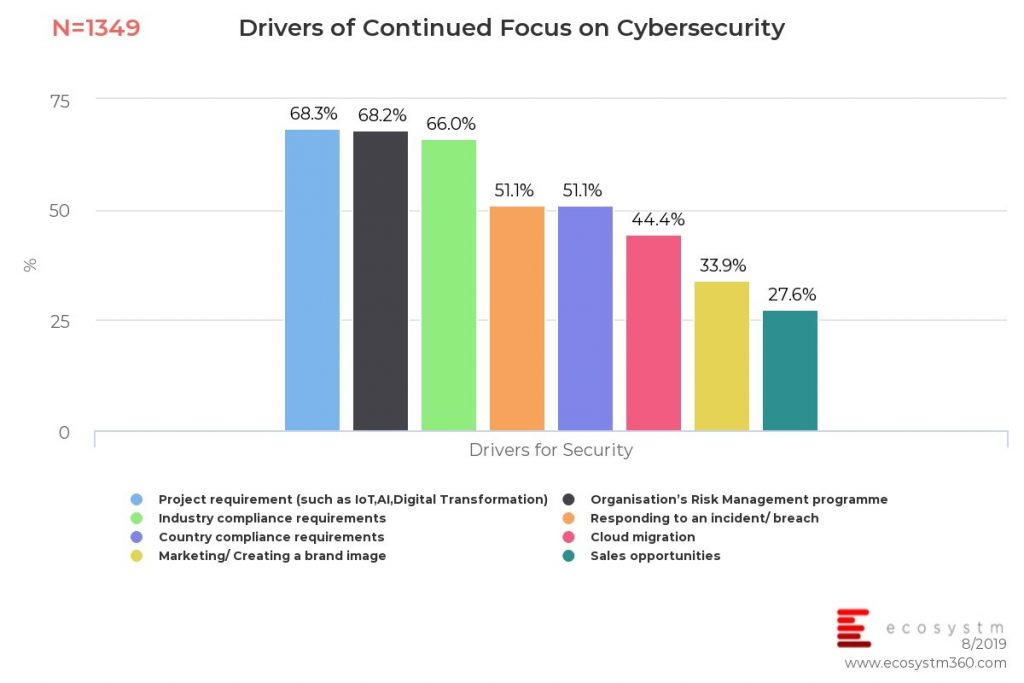
Cybersecurity encompasses a range of technologies designed to protect endpoints and networks from unwelcome intrusions and to ensure continued reliability. Cyber-attacks have become a major issue and not taking care of security can have large and long-lasting repercussions. A Cybersecurity strategy is becoming a necessity for digital business to protect the infrastructure and data assets.
In these early years of the 21st century we have witnessed a lot of innovations that have transformed how we work and do business. While DX allows process automation, improves accuracy and enhanced applications, there are those that are still sceptical and are concerned about the potential negative disruption to the traditional ways of doing things. The benefits that we are deriving from DX – and those that we will continue to derive – will outweigh the scepticism and positively impact businesses and society, on multiple levels. DX is sweeping the world and the future is here, now.

To drive its digital transformation initiatives, the Government of New Zealand recently published a roadmap ‘Growing innovative industries in New Zealand: From the knowledge wave to the digital age’, which outlines the strategic objectives of the Government to uplift and drive innovation for the country’s industries. The policy is focused on achieving a sustainable and productive economy for the country. The central elements for the plan were developed in consultation with all the key industry players and include the ideas necessary for transitioning the economy.
The Government will primarily focus on four significant sectors for its Industry Transformation Plans: food and beverage, agritech, forestry and wood processing, and digital technologies. For this, the government will work with businesses, workforce, and Māori to determine the best path towards to achieve their goals.
Agritech Industry Transformation Plan
New Zealand’s agritech sector spans across a range of technologies including genetics, information and communications technology, machinery and equipment, including robotics. The government is working with industry body ‘Agritech NZ’ and other relevant entities to draft a strategy and action plan for agritech transformation in New Zealand. The objective is to support production, drive innovation and increase exports for New Zealand’s industry.
Commenting on the NZ’s digital transformation Ecosystm Principal Advisor, New Zealand-based Jannat Maqbool, said “the agriculture sector needs to focus on innovation in order to compete and thrive as global trends and consumer demand presents challenges in feeding the growing global population. Investment in programmes driving investment in technologies and related initiatives to boost innovation and productivity in the sector will support the growing Agritech sector including work to scale Agritech businesses internationally.”
Digital technology opportunities
To support the ongoing development of New Zealand’s technology and industrial sector, the NZ government is taking several actions. The government has plans for more coordinated action between industry and the Government. Including:
- Continuing work with the IoT Alliance and the AI Forum to drive applications of digital technologies;
- Implementing Industry 4.0 programmes to increase uptake technologies and processes across manufacturing sectors, improving productivity and competitiveness;
- Coordinating, developing and rolling out a National Digital Infrastructure Model to generate value from data for all aspects of the economy–e.g. infrastructure management and development;
- Supporting New Zealand digital technology firms by providing a level playing field for New Zealand firms to compete for government business;
- Working through the Digital Skills Forum to ensure the digital technology sector, and the industries that rely on digital technology workers, can access the tech talent needed to support the growth of these sectors and the economy.
With Government setting itself for the fourth industrial revolution, there will be certain challenges and opportunities in the implementation, “the opportunity is for increased productivity and to focus more on value add to compete internationally whereas a key challenge will be finding the skilled employees that will be required as industry 4.0 is adopted” said Maqbool.
Journey of NZ industries for digital transformation
SMEs make up over 97 percent of enterprises in New Zealand and digital transformation presents an opportunity for accelerated growth and competitiveness, potentially contributing US$7 billion to New Zealand’s GDP. “Digital transformation requires awareness, adoption and effective change management but before all of this there needs to be a shift in mindset of those in charge or a changing of the guard so to speak to understand and appreciate that the move is necessary, not only for the business itself but for bridging the digital skills gap and supporting a region’s productivity and economic growth ” said Maqbool.
The Government has also created plans for tourism, creative industries, aerospace, renewable energy and health technologies for the digital push. These advances will facilitate the development of new industries in New Zealand.
“It essential that efforts through government initiatives align with other approaches already driving the move to digital in order to ensure available resources are effectively utilised and for ongoing sustainability,” says Maqbool.
Most countries recognise the importance of digital technologies and have developed or are developing national digital strategies. Many of these efforts tend to be cookie-cutter approaches with a Christmas tree of initiatives. Such plans often borrow from others without customisation or contextualisation, while incorporating whatever happens to be the flavor of the month. We would argue that any attempt at a digital strategy should start with a strong sense of focus. In such endeavors, less is often more. Plans should also articulate overarching values, principles, and frameworks that can serve as a compass to set direction and bring a sense of coherence to disparate efforts by multiple stakeholders. Finally, no strategy is complete without a proper sequencing of initiatives.
Given the rapid digitalisation of economies across the world, we are fast moving from a paradigm that considers the digital economy within well-defined sectoral boundaries, to one where digital technologies are becoming ubiquitous – touching every facet of society. The phrase “digital economy” is losing significance as the economy itself becomes digital. In a context where digital technologies are getting embedded and enmeshed across the economy, the complexity of developing, coordinating and implementing national digital strategies has become a daunting task. The rapid rate at which new technologies and business models are emerging, makes it even harder for policymakers to keep pace.
In an environment of exploding complexity and rapid change, it is crucial to adopt a more structured and, in some sense, a more minimalist approach to digital strategy. Ideally, such an approach should look at digital strategy from four perspectives:
- Focus. Identification of the most critical areas that can have cascading impacts across the economy
- Guiding compass. Defining a broad set of values, principles, and frameworks to guide action by multiple players and align strategy to the achievement of societally relevant goals
- Organisational design. Redefinition and reinvention of the organisational structures of government to contend with fast moving technologies and business models
- Sequencing. Determination of the sequencing and timing of various policy interventions.
To elaborate further on these four dimensions:
Focus
Digital technologies are not an end in themselves but are tools for achieving societal objectives. Examples of such goals are national development plans, or the United Nations Sustainable Development Goals (SDGs). Another example is Kate Raworth’s ‘Doughnut Economics’ which wisely aims to balance planetary with societal goals.
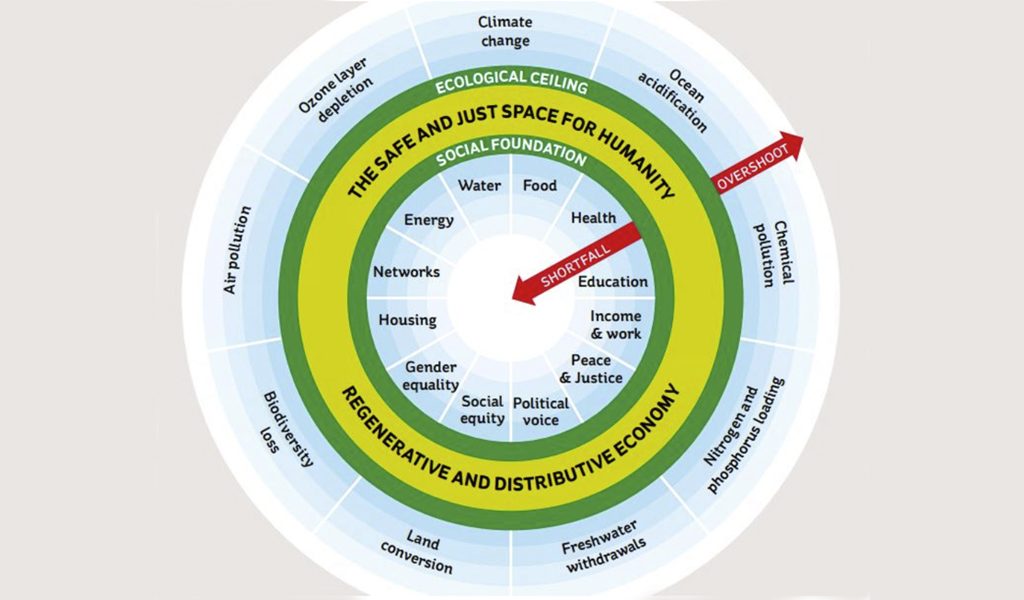
Donut Economics, Kate Raworth
Keystone Objective. National development goals/SDGs tend to be broad in their scope, and there is a danger of efforts becoming too diffuse when incorporated as part of a national digital strategy. There may, therefore, be a need to sharpen the focus further. One approach might be to identify a keystone objective which can potentially have cascading impacts across the economy and use it for providing strategic focus. Such a keystone would help reduce/eliminate redundancies and wasteful investments. In the corporate sector, Paul O’Neill’s singular focus on “zero worker injuries” while leading Alcoa is an enduring example of success.
A digital strategy that follows the various causal links to achieve the keystone goal of ‘Good Jobs for All’ as an example would end up touching upon every important aspect of the digital economy. It would be an interesting parallel to William Blake’s poem of seeing the “world in a grain of sand”.
Problem Statements. A great way of achieving focus is to identify problem statements and use them to solicit innovative solutions. Some leaders in digital government, e.g., Israel’s Ministry of Health, the Monetary Authority of Singapore, and the EU (among others) have been pursuing such an approach with a fair degree of success.
Guiding Values, Principles and Frameworks
National digital strategies would benefit from the adoption of values, principles, and frameworks that could provide broad guidance to multiple players undertaking their digitalisation initiatives. Having a directional compass would offer strategic alignment and cohesion – while allowing for innovation and creativity on the part of individual actors.
Example of Values. Values are the touchstone to decide what should be prioritised and to what purpose. Openness, positive impact, empathy, and compassion are excellent values adopted by many successful organisations.
Example of Guiding Principles. The UK has recently come up with the Gemini Principles for a National Digital Twins strategy:
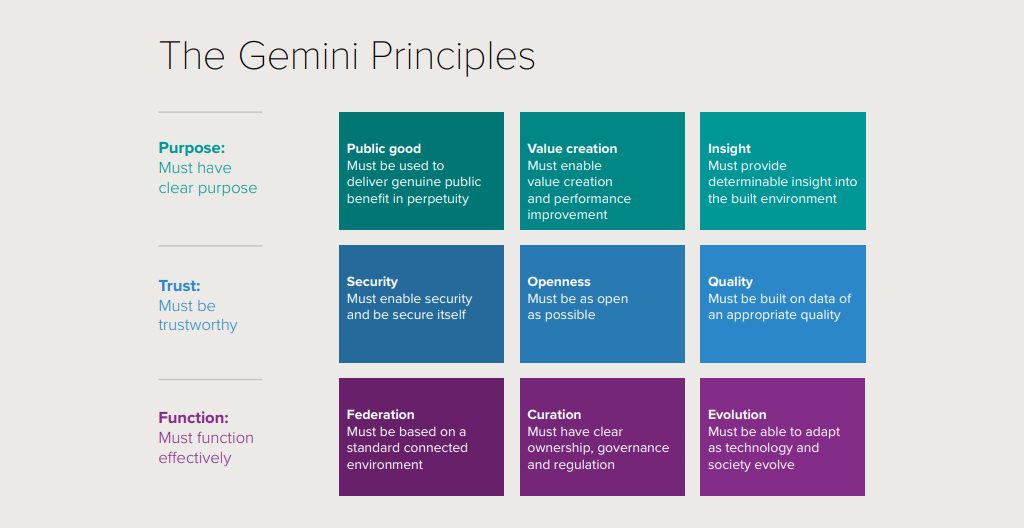
Gemini Principles for a National Digital Twins strategy
Example of a Framework. The OECD has formulated a six-dimensional Digital Government Framework:
1. From the digitisation of existing processes to digital by design
2. From an information-centred government to a data-driven public sector
3. From closed data and processes to open by default
4. From a government-led to a user-driven administration
5. From government as a service provider to government as a platform
6. From reactive to proactive policy making and service delivery
Organisational Design
Existing organisational structures of government are primarily designed for an analog world and need to change to become more relevant in the digital era. A good starting point for an organisational redesign is the area of digital regulation which often adopts a narrow sectoral approach that is likely to be sub-optimal. Also, the rapid pace of technological change typically results in laws and rules lagging technology.
Digital regulation needs to be designed from the ground up to be cross-sectoral, cross-border, cross-platform, public-private, and technologically oriented. Given that digital technologies are general purpose technologies, their regulation should be cross-sectoral as a horizontal, rather than as a vertical. Given that data flows are often agnostic to national boundaries, and the most valuable tech companies (e.g., social media companies) are outside most national borders, it is essential to bring a cross-border perspective to regulation. Similarly, the oversight of Over the Top content (OTTs), for example, requires cross-platform approaches.
If regulatory actions have to keep pace with technology, it will be necessary for regulators to work upstream with innovators and startups through strong public-private partnerships.
Some countries starting with the UK have established regulatory sandboxes to work closely with the private sector. Regulators will also have to leverage technology better in the future to retain their relevance. A case in point is tackling online harms. It may be impossible to prevent the spread of harmful content on social media, without the use of automated safety technologies.
Sequencing
A sound digital strategy should have a correct sequencing of actions for promoting the digital economy. Foundational elements, e.g., broadband networks, ease of data access, cybersecurity, digital skills, agile regulation, and entrepreneurship deserve precedence over other aspects.
Finally, to paraphrase Boon Siong Neo and Geraldine Chen in their book ‘Dynamic Governance,’ in developing a national digital strategy it is crucial to think ahead, think across, think big, and think again.
Is the IoT fueling a Digital Ecosystem to enable widespread Digital Transformation?
Ready or not, digital transformation (DX) is here and is already revealing its impact on every aspect of our lives. In some cases, the transformation is obvious. Take the way we call for a ride-share or taxi, find a room to stay, or chat to a robot for your favourite song – these are all part of mainstream DX. More subtle examples, with a Digital Ecosystem working behind the scenes, can be found in things like checking out at the retail store without ever opening your wallet or jumping into the latest automobile and getting your directions mapped out for you.
DX is often described as the integration of digital technology into all areas of business while changing how you operate and deliver value to customers. Advancements involving cloud computing, analytics, social and mobile technologies are reshaping the customer experience (CX) and opening the door for innovation and new business services. DX is also a cultural change that requires organisations to continually experiment with new ideas while being comfortable with failure and accepting that speed has become a business imperative for everyone.
DX will fundamentally change the way we think about creating a product and how we take it to market. Gone are the days of ‘make and sell’— that is, finding a market (after the fact) for the latest bright and shiny invention or innovation and forgetting about the “thing” that’s left behind with the customer. We have flipped from building stagnant technology-for-technology’s sake, as well as having little or no real-time information about most of the product’s lifecycle, to now creating customer-centric solutions teeming with data about everything at all times.
What’s fueling this major shift? The widespread connection of things to the Internet that had never been connected before, including machine-to-machine connectivity. All thanks to embedded smart sensors making IoT an omnipresent phenomenon. By 2025 there will be over 80 billion ‘things’ connected to the Internet which in turn will provide input to feed digitally transformed companies. Industrial business models everywhere will also flip to a ‘sense and respond’ environment where customers and suppliers will know almost everything there is to know about the service or product being sold and delivered to us (within the realms of data privacy regulations).
The Emergence of the Digital Exchange
In the midst of this DX there is vast opportunity: a new customer engagement model to make things better and easier for everyone. Digital businesses cannot be built and serviced by a single supplier – it’s just too complex. There are too many new sources of IoT data that are used to feed business systems and to drive outcomes. Instead, we are seeing businesses that serve the same set of customers from consortia or digital ecosystems or digital exchanges made up of a wide range of participants with an equally wide range of talents and needs.
As more companies become digital, we expect that there will be thousands of ecosystems in existence across every industry. In this collaborative environment, companies with a mutual interest in a particular industry — sometimes crossing traditional industry lines — will join a digital exchange whereby they can openly innovate and scale their business by tapping in to a global community. Just think of the power and value of the exchange as being similar to the network effect (something like Metcalfe’s Law) whereby the more the participants engage in activities in the exchange, the more value everyone gets out of the digital exchange. Microsoft’s Satya Nadella calls this “creating more surplus outside us.”
Some of the key benefits we can expect from the digital exchange are:
- Co-innovation between startups looking for partners and established vendors looking for external ideas for product improvement
- Collaboration to solve like-minded industry challenges
- Creation of open and interoperable tools to speed up new products and services offerings
- Ability to leverage a large and diverse set of partners who can help each other discover new markets and services within their own industry and beyond
Digital exchanges can be wild and confusing, and they may seem disorganised to the newcomer. Think of the first impression you have when you walk into a large open-air market selling antiques. Initially everything seems to be piled into stalls with no logical reason. However, to the experienced shopper and stall owner, there is an organised manner to it that makes sense. And there are many wonderful things waiting to be revealed.
At this year’s Hannover Messe an original example of a digital exchange was rolled out by Schneider Electric called Schneider Electric Exchange — their digital ecosystem and business platform. Schneider Electric Exchange also has a structure to it that is geared up to help specific roles or personas and make it easier for anyone to find the right partner for solving specific business challenges. It is also set up to step someone through the life-cycle process of creating a solution by connecting them to the right tools with the right partners for the right markets. Business value can be created within the Exchange but is equally powerful outside when delivered to the end user. For example, building management designers can use Schneider Electric Exchange to find partners who are also experts of emerging technologies such as digital twins, 3D-Print, AR, and analytics.
We believe that digital exchanges will create immediate economic benefits by reducing friction and inefficiencies in the overall customer supply chain. Participants will be able to innovate faster and deliver quicker — even as customers’ experiences and expectations rise, evolve, and change at the lightning pace of the digital economy. Over time we expect that vendors’ Net Promoter Score (NPS) to rise as a result of improved business processes from these exchanges.
In conclusion, IoT will be the pebble that creates the ripple in the DX pond. Data will be created from every sensor that will be used to create competitive differences at every stage of a company’s value chain. Businesses that do not embrace the use of the data and innovate themselves as well as their products do run the risk of being very quickly disrupted. Companies also do not have the financial and technical resources to do all of this by themselves – hence, the opportunity to be part of a digital exchange is the way to be agile, cost-effective, and competitive. Every time, businesses that waited while a new ‘industrial revolution’ was taking place, lost out. Today, who will dare to disrupt instead of being disrupted? We are at the tipping point of digital transformation and there is no time left to sit on the sidelines – businesses need to jump in to a dynamic digital ecosystem and partner with each other through their industry’s digital exchange!
Digital transformation has become the talk of the town. Over the last decade, organisations across the world have pushed towards digitisation – at first to share information, before moving on to relationship-building via social media and direct commerce.
Buyers have become more informed and savvy, and often have unfettered access to alternative sales channels, creating an increased need for companies to up their game – particularly those who didn’t start life in the digital space.
Indeed, a successful digital transformation has become essential for traditional incumbents to compete with young, digital disruptors, who are often cheaper and more nimble. So businesses scramble to deploy new technologies in the hope they’ll gain back their competitive advantage.
However, industry figures suggest that 9 out of 10 digital transformation projects fail – half, spectacularly so. Clearly, something is going wrong.
Using Ecosystm insights based on interactions with technology buyers from multiple industries, along with secondary research, I’ve come to the conclusion that any attempt at digital transformation should adhere to the following 10-step plan.
1. Know Your Purpose
Before embarking on any digital transformation project, ask yourself ‘why’?
Most cases are triggered in response to market changes, whether that’s changing customer demands or an evolving competitor landscape – and that’s not a bad place to start. However, it’s rarely enough to sustain a project, because that in itself is not a purpose so much as a knee-jerk reaction.
Purpose should be something that provides a tangible benefit to the organisation – for example, productivity gains, efficiencies or access to new markets and market segments.
2. Begin With Customer Needs
The best place to start defining your purpose is almost always related to customers or end-users. Disruption is everywhere, but it only takes place when players tap into a need among customers previously unmet. Businesses must therefore identify these needs, even if these needs are those of internal “customers” i.e. employees. These needs may change as you progress and you should be open to re-evaluating projects to keep pace.
3. Build A Business Case
The business case is essential for securing buy-in from senior management To convince them, you’ll need to be clear, concise and in line with the priorities and strategy of the organisation. You should clearly state objectives and anticipated results, as well as potential consequences of not implementing the project. A good business case should instil a sense of urgency.
4. Define Success
If your reasoning for digital transformation is well-founded, key success criteria should be relatively easy to define and closely-linked to your purpose. It’s also important to consider successes that relate to the implementation process itself, which can often be difficult and time-consuming. These criteria could include business satisfaction, team involvement and employee engagement or training. Make sure that all criteria measurable. That way, you can measure and share successes throughout implementation to maintain leadership support and demonstrate accountability.
5. Secure Leadership Champions
Transformation projects often face stiff internal resistance – so it’s critical to get members of senior management on board with the plan to see it through to fruition. Chances are that you will need more than just their approval, and that they’ll need to actively support and drive the project with you.
6. Get Funded
Yes, like any other complex IT project, digital transformation requires proportionate investment – both monetary and resource-wise. Make sure the whole project is funded from the outset, and that the organisation understands the full implications of the project including, wherever possible, an overview of hidden costs such as temporary drops in productivity. This implies that all relevant business units should be involved from the early planning stage, and their input incorporated into the overall plan.
7. Manage Stakeholder Involvement
That said, be careful not to end up in a situation where you have “too many cooks”. Different business units will have their own agendas and may well not agree with the priorities or even the strategic focus of the project. Others will have urgent needs that make them push for short-term or stopgap solutions, so you’ll need to be able to manage their expectations. Also, make sure you communicate your purpose when dealing with external partners, and be ready to manage them just as you manage internal stakeholders.
8. Watch Out For ‘Legacy Roadblocks’
Your interactions with stakeholders will give you an opportunity to identify the potential ‘legacy roadblocks’ in the organisation – not just in terms of technology, but also individuals who may become obstacles due to ‘legacy mindsets’, accustomed to and comfortable with the old way of doing things. Learning how to navigate them may prove essential to the project’s success.
9. Develop A Project Narrative
Digital transformation projects can cause considerable anxiety among employees. If the project involves restructuring, consider developing a narrative to help communicate and clarify the effects of transformation. This narrative should tell a compelling story of how market dynamics are changing, why transformation is therefore necessary, and what impact this will have on the organisation. It won’t necessarily soften the blow of redundancy, but it will help explain why the situation is unavoidable and minimise opposition.
10. Never Settle
Digital transformation never ends. The whole point is to be able to respond to the ever-changing dynamics of the market, and that means you can’t rest on your laurels. Keep your ear to the ground and continue to collect feedback from customers and stakeholders so that you can make continual adjustments.


